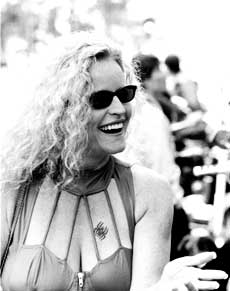Outside The Door
A couple of things: The DVD player will not connect to my black and white television set with the cables I have in hand, so I guess I'll look at buying the matching Sony television set to go with it. I wasn't planning on getting one of the very big ones, but a nice one, none the less, from the series that hooks up to this particular player. I'm sure I'll make all happen in the next day or six or twelve months. I do tend to dawdle. It also says it plays audio DVD's, about which I know nothing, so I guess I will run cables to the stereo system too. You have no idea how many cables I have in this poor, small, almost big enough for living room. Or, then, again, maybe you know all too well. This is, after all, the Net and the 21st century.
In looking at my contact sheets and negatives of the Gay Pride parade, I notice I may have made a
 mistake in my camera settings and screwed some of them up. Well, maybe a lot of them up. Not to worry, just another photography lesson in a life of photography lessons. I say I'm going to go out and buy a television set over the weekend, but maybe I'll buy some of those developing tanks and timers and thermometers and stuff and start developing my own black and white film. The development of the film is easy if you're careful, but I'd rather not do the contact sheets. Contact sheets are easy in the sense that it doesn't matter if you screw up one or two as you can always go back and run them again, but it means developing trays, boxes of photographic paper and messy chemicals. Film development takes place in a no big deal somewhat larger than a coffee cup tank. Trays are large and messy and you have to stack them up to dry in the bathroom and they just sit there and smell of fixer and acetic acid. Maybe I'll do the film and have the camera shop do the contact sheets. (Ah. Of course.)
mistake in my camera settings and screwed some of them up. Well, maybe a lot of them up. Not to worry, just another photography lesson in a life of photography lessons. I say I'm going to go out and buy a television set over the weekend, but maybe I'll buy some of those developing tanks and timers and thermometers and stuff and start developing my own black and white film. The development of the film is easy if you're careful, but I'd rather not do the contact sheets. Contact sheets are easy in the sense that it doesn't matter if you screw up one or two as you can always go back and run them again, but it means developing trays, boxes of photographic paper and messy chemicals. Film development takes place in a no big deal somewhat larger than a coffee cup tank. Trays are large and messy and you have to stack them up to dry in the bathroom and they just sit there and smell of fixer and acetic acid. Maybe I'll do the film and have the camera shop do the contact sheets. (Ah. Of course.)
I don't know how you do black and white photography using someone else to develop your film unless you really know and trust the person doing the development. (Well, actually, I know exactly how you do photography without doing the development yourself. What I don't know is how to do good photography with someone else doing the development.) I've talked about this before and done nothing (of course), so maybe this is just another chapter in that never ending book. Then again, who knows? I'm as curious as anyone.
I've been acquiring black and white photography books lately. There's a series of Pro Lighting books that displays individual photographs followed by diagrams and notes explaining the lighting setup used during the shoot: Various soft boxes, snoots, standard lamps with barn door heads, spots, light brushes, backdrops, reflectors, props and all kinds of neat stuff that I undoubtedly need to own. (Kinda like that television set.) This is studio stuff: Posed models with all of the paraphernalia you need to make professional looking images.
The objective, as near as I can tell (filtered through my own precarious set of sensibilities), is into get into a controlled environment and produce what I'm essentially looking to capture with my street shooting. I wonder what kind of results I might get? No reason not to find out. Models are available, both amateur and professional. The only critical condition for me is to have a clear idea of an image going in and then take it from there. In with one idea, out with another. If it works, good, if not, there's a street full of people waiting just outside the door.
|